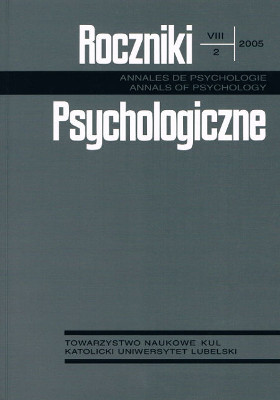Privacy as a need “localized in” self-concept
Abstract
The article presents privacy as a multidimensional need “localized in” self-concept. The main purpose of the research was to find links between need for privacy and some other human needs. Two methods were used: ACL and Social Preferences Questionnaire. The results show that need for privacy is not merely the opposite of need for affiliation and cannot be reduced to a process of maintaining the individual’s autonomy. However, there are correlations between need of exhibition, need of heterosexual contacts, amount of revealing information (number of checked adjectives) and privacy. Additionally need for privacy is the same for women and men but associated with different elements of self-concept (for each sex).
References
Archea, J. (1977). The place of architectural factors in behavioral theories of privacy. The Journal of Social Issues, 33, 3, 116-137.
Argyle, M. (1991). Psychologia stosunków międzyludzkich. Warszawa: PWN.
Aronson, E. (1999). Człowiek – istota społeczna. Warszawa: PWN.
Biela, A. (1988). Theoretical and methodological problems of the self in psychology. W: A. Biela, Z. Uchnast (red.), Problems with the self in psychology. Selected papers presented during the Symposium in Kazimierz, Poland 4-7 May 1988 (s. 23-42). Lublin–Bielefeld.
Boucher, F. (2003). Historia mody. Dzieje ubiorów od czasów prehistorycznych do końca XX wieku. Warszawa: Arkady.
Brzezińska, A. (1973). Struktura obrazu własnej osoby i jej wpływ na zachowanie. Kwartalnik Pedagogiczny, 3, 87-97.
Brzeziński, J. (1999). Metodologia badań psychologicznych. Warszawa: PWN.
Derleta, V. J., Chaikin, A. L. (1977). Privacy and self-disclosure in social relationships. The Journal of Social Issues, 33, 3, 102-115.
Dyczewski, L. (1992). Rodzina a prywatność i życie publiczne. W: L. Dyczewski, J. Krokowski, G. F. McLean (red.), Prywatność i życie publiczne w nowoczesnym społeczeństwie USA-Polska (s. 97-115). Lublin: Towarzystwo Naukowe KUL.
Erikson, E. H. (1997). Dzieciństwo i społeczeństwo. Poznań: Dom Wydawniczy Rebis.
Gough, H. G., Heilbrun, A. B. (1980). The Adjective Check List. Manual. Palo Alto: Consulting Psychologists Press.
Hall, C. S., Lindzey, G. (2001). Teorie osobowości. Warszawa: PWN.
Jarymowicz, M. (1994). Poznawcza indywiduacja a społeczne identyfikacje: model zależności pomiędzy odrębnością schematów Ja–My/Inni i gotowością do identyfikowania się z innymi. W: M. Jarymowicz (red.), Poza egocentryczną perspektywą widzenia siebie i świata (s. 107-125). Warszawa: Wydawnictwo Instytutu Psychologii PAN.
Kelvin, P. (1973). A social-psychological examination of privacy. British Journal of Social and Clinical Psychology, 12, 248-261.
Kozielecki, J. (1986). Psychologiczna teoria samowiedzy. Warszawa: PWN.
Laufer, R. S., Wolfe, M. (1977). Privacy as a concept and a social issue: A Multidimensional Developmental Theory. The Journal of Social Issues, 33, 3, 22-42.
Leary, M. (2003). Wywieranie wrażenia na innych. O sztuce autoprezentacji. Gdańsk: GWP.
Łaguna, M. (1996). Budować obraz siebie. Lublin: Towarzystwo Naukowe KUL.
Łukaszewski, W. (1979). Teoria osobowości a badania nad spostrzeganiem własnej osoby a spostrzeganiem innych ludzi. W: W. Łukaszewski (red.), Spostrzeganie siebie i spostrzeganie innych ludzi (s. 5-11). Wrocław: Wydawnictwo UW.
Margulis, S. T. (1977). Coceptions of privasy: Current status and next steps. The Journal of Social Issues, 33, 3, 5-21.
Margulis, S. T. (2003a). On the status and contribution of Westin’s and Altman Theories of Privacy. The Journal of Social Issues, 59, 2, 411-429.
Margulis, S. T. (2003b). Privacy as a social issue and behavioral concept. The Journal of Social Issues, 59, 2, 243-261.
Maslow, A. H. (1954). The instinctoid nature of basic needs. Journal of Personality, 22, 226-247.
Newell, P. B. (1995). Perspectives on privacy. Journal of Environmental Psychology, 15, 2, 87-104.
Obuchowski, K. (1995). Przez galaktykę potrzeb. Poznań: Wydawnictwo Zysk i S-ka.
O’Connor, S. C., Rosenblood, L. K. (1996). Afiliation motivation in everyday experience: A theoretical comparison. Journal of Personality and Social Psychology, 70, 3, 513-522.
Peachey, P. (1992). Rodzina–społeczeństwo–państwo w Stanach Zjednoczonych. W: L. Dyczewski, J. Krokowski, G. F. McLean (red.), Prywatność i życie publiczne w nowoczesnym społeczeństwie USA-Polska (s. 83-94). Lublin: Towarzystwo Naukowe KUL.
Pedersen, D. M. (1979). Dimensions of privacy. Perceptual and Motor Skills, 48, 1291-1297.
Pedersen, D. M. (1982). Cross-validation of privasy factors. Perceptual and Motor Skills, 55, 57-58.
Pedersen, D. M. (1987). Relationship of personality to privacy preferences. Journal of Social Behavior and Personality, 2, 2 (Part 1), 267-274.
Pedersen, D. M. (1988). Correlates of privacy regulation. Perceptual and Motor Skills, 66, 595-601.
Pedersen, D. M. (1994). Privacy preferences and classroom seat selection. Social Behavior and Personality, 22, 4, 393-398.
Pedersen, D. M. (1996). A Factorial Comparison of Privacy Questionnaires. Social Behavior and Personality, 24, 3, 249-262.
Pedersen, D. M. (1997). Psychological functions of privacy. Journal of Environmental Psychology, 17, 147-156.
Pedersen, D. M. (1999). Model for types of privacy by privacy functions. Journal of Environmental Psychology, 19, 4, 397-405.
Pedersen, D. M., Frances, S. (1990). Regional differences in privacy preferences. Psychological Reports, 66, 731-736.
Pervin, L. A., Oliver, P. J. (2002). Osobowość. Teoria i badania. Kraków: Wydawnictwo UJ.
Petronio, S. (2002). Boundaries of privacy. Dialectics of disclosure. New York: State University of NY Press.
Reykowski, J. (1980). Osobowość a społeczne zachowanie się ludzi. Warszawa: Książka i Wiedza.
Strelau, J. (2000). Psychologia. Podręcznik akademicki. Gdańsk: GWP.
Vasta, R., Haith, M. M., Miller, S. A. (1995). Psychologia dziecka. Warszawa: Wydawnictwa Szkolne i Pedagogiczne.
Walden, T. A., Nelson, P. A. Smith, D. E. (1981). Crowding, privacy and coping. Environment and Behavior, 13, 205-224.
Weinstein, C. S. (1982). Privacy-seeking behavior in an elementary classroom. Journal of environmental Psychology, 2, 23-35.
Westin, A. (1967). Privacy and freedom. New York: Athenaeum.
Wiśniewski, A., Śleszyński, D. (1976). Koncepcja hierarchicznej struktury potrzeb w teorii Abrahama H. Maslowa. Studia Philosophiae Christianae, 12, 2, 192-211.
Zaborowski, Z. (1989). Psychospołeczne problemy samoświadomości. Warszawa: PWN.
Zaleski, Z. (2001). Prawo do prywatności – aspekty psychologiczne. W: K. Motyka (red.), Prawo do prywatności. Aspekty prawne i psychologiczne (s. 95-145). Lublin: Wydawnictwo MORPOL.
Zaleski, Z. (2003). Psychologia własności i prywatności. Warszawa: Wydawnictwo Akademickie „Żak”.
Copyright (c) 2005 Roczniki Psychologiczne

This work is licensed under a Creative Commons Attribution-NonCommercial-NoDerivatives 4.0 International License.


